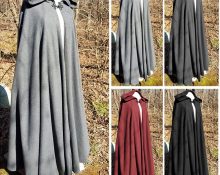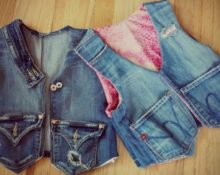
creativecommons.org
The unique patchwork technique is a real find for creative individuals who love to create exclusive things with their own hands. It allows you to create amazing things from the simplest materials. The essence of the technique is that, using numerous small scraps of different colors, the needlewoman forms a finished product from them. According to some beliefs, technology came to us from the ancient Russian hinterland. It was difficult for women to get any fabric; all materials were in short supply. Therefore, the ladies tried not to throw away even the scraps. They found a use for them, sewing them together into blankets, rugs, bedspreads and other things.
Afterwards, “patchwork” was undeservedly forgotten for a long time. Only in the eighties did the first mention of old Russian technology appear in a fashion magazine, but with a new name. The advantage of this technique is that absolutely any material can be used.Products can be knitted or sewn with needles. Today, a knitted patchwork vest is a real fashion trend. Every stylish girl dreams of having such a thing in her wardrobe.
A DIY patchwork vest is a unique product assembled from dozens of scraps. Sometimes craftswomen use knitting needles, but in most cases a crochet hook is used. The downside is that such a thing will not look very nice from the inside due to the abundance of seams. But externally, the patchwork vest looks excellent.
Do-it-yourself patchwork vest - preparation of materials
Before starting work, you do not need a pattern for the vest itself, but the material base must be ready. What you need to make a knitted patchwork vest yourself:
- The yarn is four hundred gram balls, two hundred meters long. Thread thickness is from four to five millimeters. It is advisable to avoid contrasts when choosing colors. For example, combinations of soft blue, emerald, blue, and turquoise will look good.
- Number two and five needles for craftswomen accustomed to loose knitting. For those who like tight knitting, knitting needles number 3 are suitable.
- Centimeter, paper, pencils.
- Laptop, tablet or computer.

creativecommons.org
Patchwork style in clothing - jackets, vests, what measurements are needed
One of the advantages of a patchwork knitted vest is the freedom of execution style. There is a certain scheme, for the compilation of which a simple computer program is used. This is a standard editor in which it is possible to create tables. A specific color distribution plan is built, and a description of the work process is added if desired.Before you start knitting a patchwork vest, you should take measurements:
- Vest length.
- Back width.
- Armhole - height.
- Hip volume if the vest is below the waist.
- Waist.
These are all the measurements that need to be taken before starting knitting. If we are talking about a women's sleeveless vest up to size 44, then the approximate length will be 50-60 centimeters, the waist volume will be up to seventy centimeters, the hips will be up to 93. The height of the armhole can be calculated as twenty centimeters.
How to sew a patchwork vest - DIY patchwork vest
A vest consisting of multi-colored elements of the same range looks the most stylish and interesting. The preferred shape of the patches is diamonds or rectangles. The main rule of “patchwork” is the random arrangement of parts. To choose the optimal color distribution, you should draw a plan in the program. When the plan is completed, the resulting structure is converted into loops. Let's look at an example:
- The number of lower loops is 182. This is almost the full volume of the hips. Edge seams are also taken into account - two pieces. It is recommended to take a slightly smaller volume than in the measurements if the vest is shorter than the hip measurement point.
- The shreds will be five centimeters high. Therefore, it is necessary to knit 8 rows. Nowadays there are special knitting needles for knitting patchwork products, which can be purchased at any professional knitting store.
- You need to cast 182 loops. Then we begin knitting two rows. To create the canvas, the facial stitch technique is used. Take a gray thread. After finishing, you need to tie a knot and start a new row with a different thread, for example, burgundy color. This will be the beginning of the first square.
- Rectangles, diamonds and squares are much easier to knit by winding the yarn in small balls rather than using main skeins.
- To start the first element, take a burgundy thread, make 26 loops, fasten and knit another 40 loops in a different color. We proceed in the same way until the last tier, where you need to remove the loop of one shade in order to connect it with another color. In total, five loops are removed to match colors.
- After finishing work on the tier, it is important to secure the yarn very carefully. Then the threads are cut from the skeins.
- We collect the gray thread again and knit two rows. Five more loops are removed in the process.
- For the next tier, you need to cast on rectangles again, knit and cut the loops of the last row in accordance with the diagram. Five loops will be shortened again.
- In the gray stripe you need to remove five loops again. As a result, we get a fitted vest by removing a total of twenty loops. We continue to knit the remaining elements, relying on the diagram created on the computer. Rectangles break up the gray stripes. Gray thread is also used near the armhole at the end.
- In the armhole area for closure, according to the plan, you should remove four loops, then three more from the edges, and tie the product to the neck.
- When working with shoulders, after stripes of gray color, we cast on twenty loops, remove five loops in five rows on each shoulder.
This completes the work on the exclusive vest. The finished product must be ironed well, after which the model’s shoulders are sewn together. Now crochet the entire vest using a gray thread. During tying, you need to make buttonholes. The last step is to sew the buttons to the vest.


 0
0





